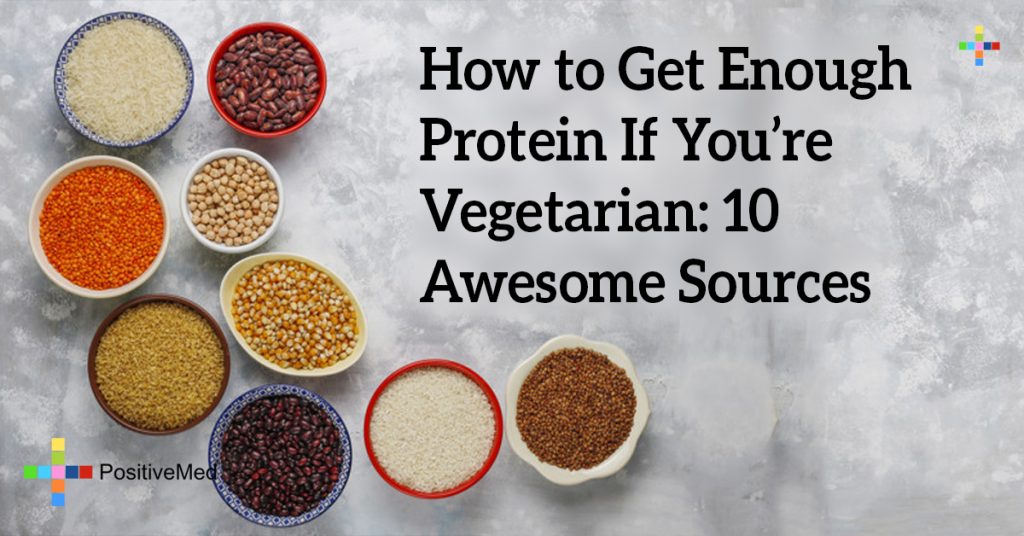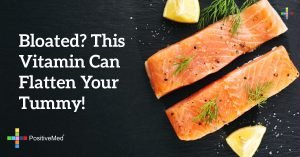
How to Get Enough Protein If You’re Vegetarian: 10 Awesome Sources
If you’ve adopted a vegetarian diet, you’re one smart cookie. Compared to carnivores, studies show that vegetarians enjoy the following health benefits:
- less body fat
- reduced blood pressure
- decreased cholesterol
- diminished risk of heart disease
- less incidence of breast, ovarian, and colon cancer
- increased longevity
- lower risk of diabetes
In 2013, University of Oxford researchers found that vegetarianism reduces heart disease risk by 32 percent.
The case for longevity was made by a 2013 study published in JAMA Internal Medicine. Vegetarians had a 12 percent diminished risk of dying than their carnivorous counterparts.
A 2011 study reported in Diabetes Care linked a vegetarian diet with a lowered likelihood of diabetes.
PROTEIN CONCERNS
Protein comprises every cell, tissue, and fluid in your body. Protein produces enzymes, hormones, and antibodies. Amino acids are organic compounds that combine to form protein. You need 22 different amino acids, nine of which your body can’t make on its own. These are termed “essential.” They must be obtained from food.
Complete proteins contain all the essential amino acids. Incomplete proteins have some of them. The advantage of complete protein is that it’s easily assimilated. In the 1970s, nutritionists believed that plant proteins must be combined to prevent a protein shortfall. The American Dietetic Association has since revised this stance. As long as you consume all the essential amino acids over the course of your day, you won’t be protein-deficient.
The Magic Numbers
RDA – The Recommended Dietary Allowance for protein is:
- 45 grams for women
- 56 grams for men
- 71 grams for pregnant and nursing women
DRI – Another way to pinpoint your daily protein need is to use the Dietary Reference Intake. The Institute of Medicine recommends 0.8 grams of protein per kilogram of body weight per day. To calculate your DRI, you first convert your weight in pounds to kilograms. Take your weight and divide it by 2.2 to get the kilogram equivalent. Then multiple the number by 0.8 to get the grams of protein. Here’s an example:
- Weight in pounds = 130
- Weight in kilograms = 130 ÷ 2.2 = 59 kilograms
- 59 x 0.8 = 47 grams of protein daily
VEGETARIANISM DEFINED
The broad definition of a vegetarian is a person who doesn’t eat meat, fish, or poultry. According to the Academy of Nutrition and Dietetics, the diet is more specifically classified in three ways:
- vegan – consists of only plant-based foods. There is no consumption of meat, fish, poultry, eggs, dairy, gelatin, lard, rennin, or honey.
- lacto-vegetarian – plant-based and includes dairy.
- lacto-ovo-vegetarian – plant-based and includes dairy and eggs.
Now we get down to the yummy details. To benefit all types of vegetarians, we’ll cover mostly plant-based proteins. We’ll spotlight sources that are currently making headlines. Scientific studies are included for these in the event they’re new to you.
PLANT-BASED ALL-STARS
1. QUINOA
The Science – A 2015 study published in BMC Medicine shows that eating a daily bowl of quinoa reduces the risk of premature death from cancer, diabetes, heart disease, and lung disease by 17 percent.
Plant Perks – Quinoa is a gluten-free, complete protein. It has 8 grams of protein per cooked cup. It’s high in iron, potassium, magnesium, and fiber. It has a light, fluffy consistency and nutty flavor. Quinoa is typically available in ivory and red varieties.
For vegetarian quinoa recipe, click here.
2. AMARANTH
The Science – Amaranth is heart-healthy. In 1996, USDA studies revealed that amaranth oil reduces cholesterol. In 2003, Canadian researchers found that amaranth has steroid compounds that block cholesterol absorption. A 2007 Russian study showed that heart disease patients who regularly ate amaranth had significant subsequent reductions in cholesterol and triglycerides.
Plant Perks – Amaranth is a cousin to quinoa. It’s a complete protein and gluten-free. It’s high in calcium, iron, magnesium, potassium, and B Vitamins. Amaranth is the only grain that’s a source of Vitamin C. Its fiber content is triple that of wheat. One cup of amaranth has 7 grams of protein.
3. HEMP
The Science – A 2015 study in the Journal of Agricultural and Food Chemistry shows that hemp’s healthy fat reduces the risk of heart disease. Plant steroids in hemp lower cholesterol. They also reduce the risk of blood clots and cancer. Vitamin E compounds called tocopherols protect against dementia.
More about HEMP you can find here.
Plant Perks – Hemp is a decent dose of complete protein in a petite package. It’s the easiest of all seeds to digest and assimilate. Two tablespoons of seeds have 5 grams of protein, 7 grams fat, and 10 percent of your RDA for iron. Hemp is high in magnesium, a mineral that confers relaxation, blood sugar balance, low blood pressure, and protection from osteoporosis. Hemp is also a potent source of calcium and potassium.
Uses – Hemp is available as oil, protein powder, seeds, and milk.
- Oil – The oil’s nutty flavor is a tasty option for dips, spreads, and salad dressings. It is not recommended to cook with the oil as heat destroys its nutritional value. Hemp oil should be refrigerated to prevent fat oxidation.
- Protein Powder – Used in shakes, hemp contributes up to 8 grams of fiber. For a nutrition-packed smoothie, try this recipe: blend ¼ cup hemp protein powder, 1½ cups almond milk, ½ cup blueberries, and 2-3 ice cubes until smooth.
- Seeds – Sprinkle on salad, mix in yogurt, and add to baked goods.
- Milk – Hemp milk is increasing in popularity. It is made by blending the seeds with water. An 8-ounce glass of hemp milk contains 50 percent of the RDA for calcium! It is reported to strengthen immunity and promote healthy skin, hair, and nails.
NOTE – Though hemp is related to the marijuana plant, it does not produce a drug-like effect or a positive result on a drug test.
4. CHIA
The Science – Chia seeds have a blood-thinning effect that protects against stroke and heart attack. This was the conclusion of 2007 research published in Diabetes Care. Additional studies of diabetic subjects have shown that chia stabilizes blood sugar and reduces systolic blood pressure. It also quells inflammation.
Plant Perks – Chia is another complete, satisfying protein. The seeds are packed with calcium, iron, magnesium, omega-3 fatty acids, fiber, and antioxidants. Omega-3 fatty acids support heart and brain function, render healthy hair and skin, and protect against depression.
Two tablespoons have 5 grams of protein. Chia tastes a bit like poppy seed. It has a satisfying crunch when eaten dry. Added to liquid, it becomes plump, sweet, and soft.
Sprinkle chia seeds over salads, soups, yogurt, wraps, and sandwiches. Add them to muffins, breads, cookies, and cakes. They can be substituted for poppy and sesame seeds in recipes. They also make a delicious pudding.
Read how to use CHIS seeds here.
5. PUMPKIN SEEDS
The Science – A 2009 study found that pumpkin seeds relieve the symptoms of an enlarged prostate. A 2011 study of postmenopausal women showed the seeds to lower cholesterol, blood pressure, hot flashes, headaches, and joint discomfort. Pumpkin seeds may lessen breast cancer risk, according to a 2012 study published in Nutrition and Cancer. Scientists surveyed the diets of over 9,000 women and found that those who ate estrogen-rich foods had significantly reduced rates of breast cancer.
Plant Perks – Pumpkin seeds are an excellent source of protein, phytoestrogens, Vitamin A, Vitamin E, iron, magnesium, zinc, and omega-3 fatty acids. Two tablespoons of seeds have 7 grams of protein and 24 percent of the RDA for iron. They’re high in tryptophan, an essential amino acid that relieves anxiety. Eat the seeds a few hours before bedtime to promote restful sleep. Magnesium in pumpkin seeds supports heart health. Zinc boosts immunity.
Uses – Power up your food by adding pumpkin seeds to cheese, pesto, soups, salads, granola, trail mix, cookies, muffins, and breads.
Find out more about health benefits of PUMPKIN here.
6. SPIRULINA
The Science – This blue-green algae has antioxidant properties. A 1995 Indian study found spirulina to cure oral cancer. After one year, 45 percent of tobacco users who consumed spirulina daily had complete regression of oral lesions. The study was reported in Nutrition and Cancer. A 2013 study in the Journal of the Science of Food and Agriculture showed that spirulina lowers cholesterol and triglycerides.
Plant Perks – Spirulina is a complete protein, with all the essential amino acids perfectly balanced. One tablespoon contains 4 grams of protein. Spirulina is a good source of Vitamins B1 and B2. It’s also high in the minerals copper, iron, magnesium, potassium, and manganese.
Uses – Spirulina is available as a powder and supplement. Some people are allergic to it, so it’s best to start with one tablespoon or two 500 mg tablets daily for one week and assess your reaction. Spirulina has an earthy flavor suited to sweet smoothies. It’s a colorful complement to beverages containing banana, pineapple, and mango. It can also be added to fruit juice, such as apple and orange.
Read more about SPIRULINA here.
NOTE – The National Institutes of Health states that spirulina should not be consumed if you:
- have an autoimmune condition, such as multiple sclerosis, lupus, or rheumatoid arthritis
- take blood-thinning medication, such as warfarin
- are pregnant or breast-feeding
- have phenylketonuria
7. TEMPEH
The Science – Tempeh is a patty made from fermented soybeans. A 1995 analysis of 38 clinical trials showed that daily soy consumption reduces cholesterol by roughly 13 percent. A 2009 meta-analysis found that soy was linked with a 26 percent reduction in prostate cancer risk. A 2010 review showed that soy offers protection against breast cancer. A Malaysian university study found that the calcium in tempeh is better absorbed than the calcium in milk. A 2013 study in the Polish Journal of Microbiology evaluated the benefits of tempeh on digestion. It found that the fermentation process produces antibiotic effects. For this reason, tempeh cures diarrhea.
RELATED ARTICLE: 7 Meat-Free Proteins
Plant Perks – Tempeh is a complete protein with nutrients that regulate hormones and reduce heart disease. A serving of tempeh yields 18 grams of protein and 10 percent of the RDA for calcium and iron. Tempeh balances blood sugar levels by virtue of its protein and fiber. If beans typically make you flatulent, you’ll be delighted by the digestibility of tempeh. Enzymes produced by fermentation break down the component carbohydrates, protein, and fat.
Recipes – Tempeh has a sweet, slightly earthy flavor. For some tempting tempeh recipes, click here.
8. NUTRITIONAL YEAST
The Science – A 2014 study found that nutritional yeast boosts immunity by increasing white blood cell production.
Plant Perks – Nutritional yeast is typically grown from sugarcane or beet molasses. It’s completely pasteurized and deactivated. Therefore, it cannot render harmful yeast overgrowth. Two tablespoons supply 9 grams of complete protein and a day’s worth of Vitamins B1, B2, B6, B12, folate, and niacin. Magnesium in yeast balances blood sugar. Zinc optimizes carbohydrate metabolism. Compounds in nutritional yeast lower cholesterol and protect against cancer. It’s gluten-free, high in fiber, and low in sodium and fat.
Uses – Nutritional yeast is available as flakes and powder at natural food stores. It has a nutty, robust flavor. Use it as a substitute for cheese. It’s a tasty topping for popcorn. Add it to rice, wraps, pasta, beans, soup, sauces, dips, greens, and veggies.
RELATED ARTICLE: Vegetarian Diet Benefits: Good Reasons to Adopt a Vegetarian Diet
ANIMAL-BASED CHAMPIONS
9. WHEY
The Science – A 2003 study in the Journal of Applied Physiology showed that whey protein improves muscle strength, exercise endurance, and immunity. It also increases muscle mass, as reported in a 2013 article in the Journal of the American College of Nutrition. Eating whey after exercise supplies the amino acids needed to repair and build muscle. The Joslin Diabetes Center cites leucine in whey as instrumental in this process. A 2012 review in Lipids in Health and Disease offers evidence that whey may lower high blood pressure. Preliminary studies reported in Anticancer Research suggest it may protect against cancer.
Health Perks – Whey protein is either separated from milk or formed as a by-product of cheese-making. It is a complete protein containing branched-chain amino acids needed for building muscle. Whey balances blood sugar and lowers cholesterol. It promotes satiety and weight loss by reducing the hunger hormone ghrelin. It diffuses stress by increasing the brain chemical serotonin, fostering well-being and happiness.
Whey protein powder is available in three forms:
- Concentrate – contains at least 90 percent protein. It’s low in fat and lactose. Concentrate is the least expensive type of whey.
- Isolate – at least 90 percent protein and free of fat and lactose. Isolate is quickly absorbed.
- Hydrolysate – a predigested source of whey. It is the most expensive, highest quality, and most readily absorbed form of whey.
Uses
- Add to oatmeal or breakfast cereal.
- Stir into yogurt.
- Substitute for water in cornbread, muffins, waffles, and pancakes.
- Soak grains in whey to make them more digestible.
- Mix into soups and stews.
- Blend in a smoothie. For easy smoothie recipes, click here.
NOTE – Do not consume whey if you take the following medications:
- levodopa for Parkinson’s disease
- alendronate for osteoporosis
- tetracycline antibiotic
10. KEFIR
The Science – A 2003 Finnish study in the American Journal of Clinical Nutrition revealed that drinking kefir for five months lowered blood pressure. A 2003 study conducted in Japan found that daily kefir consumption reduced cholesterol after a one-month period. A 2007 Japanese study showed that ingesting kefir daily increases killer cells against breast cancer.
Health Perks – Kefir and yogurt are cousins. Both are made by fermenting milk with bacteria. However, kefir has more beneficial microorganisms than yogurt. These probiotics promote digestion, mental health, and weight management. They protect against infection by inhibiting the growth of harmful bacteria. They also stimulate immunity. Kefir is low in lactose, making it easier to digest than milk.
A 6-ounce serving of kefir contains 6 grams of protein and 20 percent of the RDA for calcium, phosphorus, and Vitamin B2. Calcium and Vitamin K2 in kefir support bone health and prevent osteoporosis. Kefir is also high in potassium.
Kefir has the delicious tang of yogurt with a thinner consistency. It’s available at supermarkets and health food stores.
Uses
- Add to smoothies.
- Serve with fruit.
- Pour over cereal.
- Substitute for buttermilk in baking.
- Use as a base for salad dressing.
RELATED ARTICLE: Health Benefits of Probiotics
10 NEWSWORTHY VEGETARIAN PROTEINS
The top 10 vegetarian proteins in the media spotlight are:
1. Quinoa
2. Amaranth
3. Hemp
4. Chia
5. Pumpkin Seeds
6. Spirulina
7. Tempeh
8. Nutritional Yeast
9. Whey
10. Kefir
Here’s to your health!





